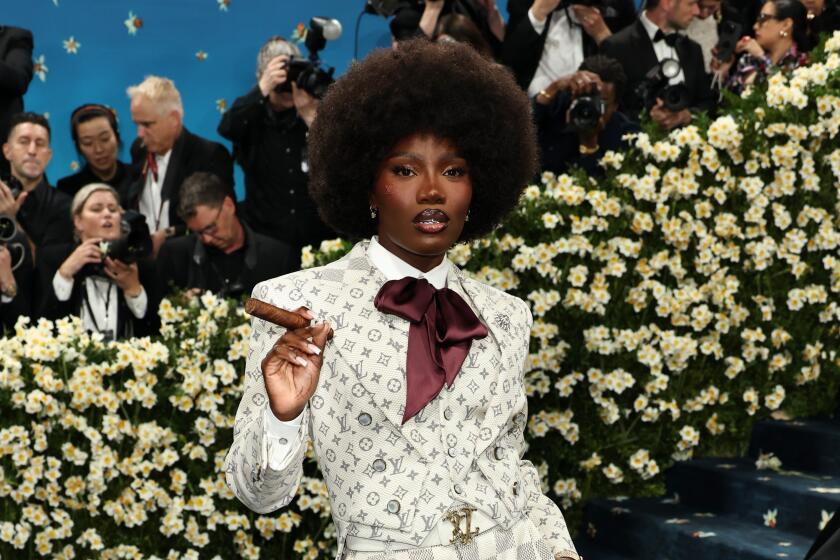Money’s Riding on CNBC Market Reporter Bartiromo
- Share via
NEW YORK — Maria Bartiromo may be the closest thing here to a combat reporter. Holding her ground on the chaotic floor of the New York Stock Exchange, she dodges round after round of zigzagging traders, while rattling off earnings reports, analyst projections and market updates into a CNBC camera and the offices of moneymakers around the country and the globe.
Live on camera, she juggles pages of notes, grabs new numbers from a producer, talks rapidly above the din.
A head-turning beauty in a war zone still overwhelmingly male, the 30-year-old Bartiromo has generated ink that’s wildly retro and over-the-top. And not only in the New York Post, which dubbed her “The Fabulous Biz Babe.” Newsweek gave her a page in which the writer went on about her “huge smoky-blue eyes. . . . As they say in the business, Bartiromo knows how to make love to a camera.” And National Review, the high-church organ of the political right, noted in passing that “somehow she has become the Sharon Stone of business cable.”
“Initially, I was flattered, frankly, by the coverage,” Bartiromo recalled during a break last week. “But at this point, it’s a little disheartening that these stories have ignored some of my achievements.”
Indeed, those achievements have prepared her--solidly--for what she describes as “the biggest challenge I’ve ever had.”
Bartiromo on Oct. 14 lengthened her workday, which begins at 7 a.m., by becoming co-anchor of the 7 p.m. “Business Center” (seen at 4 p.m. on the West Coast). Broadcast from CNBC’s headquarters in Fort Lee, N.J., the heavily promoted half-hour is a fast-paced, musically charged wrap-up and magazine, which on Monday was expanded to an hour to cover the dramatic day on Wall Street. The program marks the cable network’s bold bid to develop a signature show and compete with Lou Dobbs’ more dour “Moneyline,” which is seen at the same hour on CNN and CNNfn, its financial offshoot.
Dobbs used to be Bartiromo’s boss. Before and after her graduation from New York University in 1989, the Brooklyn native worked off-camera in CNN’s Manhattan bureau, shifting after a while to Dobbs’ business-news department. She produced pieces and wrote copy--building a bank of sources in the business and financial community that she continued to call on after CNBC hired her away in 1993 and assigned her to Wall Street two years later. She became the first reporter to broadcast from the floor of the New York Stock Exchange, displaying a striking ability to report, ad-lib and react to market news as many as 20 times a day (now half as often, and only in the morning). “In the beginning, some of the people who passed me on the floor thought I was standing there talking to myself,” she recalled.
She also writes a column for Individual Investor magazine and is completing a book on women and the brokerage industry that Harcourt Brace has scheduled for next year. And Vanity Fair, in its latest “Night-Table Reading” feature, wanted to know what book was on hers (Thomas A. Stewart’s “Intellectual Capital: The New Wealth of Organizations”).
“I’d have to say I’m one of the most plugged-in people on this beat,” she said, trying to downplay the sexy-woman angle.
Viewed from a wider angle, this junkie of interest rates and housing starts, of quarterly earnings and shareholder value, has cut a niche of a career path that parallels the rising interest of just-plain folks in the kind of news she has to offer. Since the Wall Street meltdown of 10 years ago, stock mutual funds have grown to hold more than $2 trillion, tying millions of retirement accounts (whether their owners realize it or not) to the fortunes of the stock market.
NBC started CNBC in 1989 and ensured the cable network’s future by buying and folding the competing Financial News Network in 1991. SmartMoney and Worth magazines were among the publications launched in more recent years to tap into money mania and baby boomers’ interest in personal finance, as financial publisher Michael Bloomberg launched the Bloomberg News service, Bloomberg News Radio and Bloomberg Information Television.
CNN spun off CNNfn at the end of 1995. Rupert Murdoch’s Fox News Channel entered the all-news fray last October, building a business hour around Neil Cavuto, a former CNBC anchor.
Bartiromo’s own interest in financial matters dates to her college years, when she studied economics while majoring in journalism. “I was very interested in the stock market--it was always moving,” she said. “I liked the action of making money and losing money. I enjoyed learning about how people like Ted Turner got to where they are.”
She realized how interested average consumers had become in the market and business news while on vacation at Lake Tahoe last year: “A valet parker recognized me and said, ‘Hey, Maria, what are those unemployment numbers gonna do tomorrow?’ I thought, whoa!”
Not that CNBC is playing to a huge audience. Though the network is available in about 64 million U.S. households, the record-level viewership of its business programming (Geraldo Rivera, Charles Grodin and other talk hosts take over in the evening) averaged only 153,000 homes in the third quarter.
If not critical mass, it’s certainly critical interest, for the number of CNBC viewers is much higher when counting the brokerage houses and investment firms that carry the network on their office screens throughout the day. In addition, CNBC transmits to the floor of the exchange. The network successfully lobbied to put its programming on monitors located above the various trading posts; because the talking heads could never be heard over all the noise, the CNBC dialogue appears in caption form, above the streaming stock ticker.
For Bartiromo, the new “Business Center” may quicken her route to a more visible role on the NBC network. Co-anchored by Bartiromo and Tyler Mathisen, the former executive editor of Money magazine, the show is designed to broaden the CNBC audience beyond the core viewers who already know if the Dow finished up or down. Besides rapid-fire headlines from the financial markets, “Business Center” serves up biz buzz from the entertainment and sports industries, as well as puffy features, such as a profile of “Chainsaw” Al Dunlap, the CEO of Sunbeam Corp. (“The former West Point cadet knows the art of battle”).
It’s “Entertainment Tonight” meets Wall Street, in marked contrast to CNN’s “Moneyline,” which countered the new competitor’s opening-week bells and whistles with “Panic to Prosperity,” a series of somber chats between Dobbs and others who remembered the 1987 plummet.
“Moneyline” in September averaged 393,000 households--nearly four times the measured audience watching CNBC’s “Money Club,” which Bartiromo and associates have replaced. In its first four broadcasts last week, “Business Center” averaged 196,000 households to 261,000 watching “Moneyline,” but the new CNBC show outdrew its entrenched competitor among those 25 to 54 years old, a group targeted by many leading advertisers.
As Bartiromo might size up the numbers, “There’s a lot of positives going on” at CNBC.
*
* “Business Center” is seen weekdays at 4 p.m. on CNBC cable.
More to Read
The biggest entertainment stories
Get our big stories about Hollywood, film, television, music, arts, culture and more right in your inbox as soon as they publish.
You may occasionally receive promotional content from the Los Angeles Times.










